Cyril Roger Brossard
Well-known member
- Joined
- Aug 30, 2012
- Messages
- 408
As seen here.
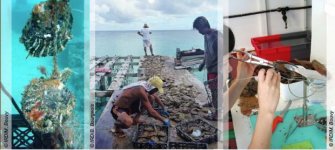
The second greatest economic resource of French Polynesia after tourism, black pearl culture has been facing a major crisis since the first decade of this century. Overproduction, falling prices, reduced activity that had boosted many remote atolls... In response, IRD researchers and their partners( 1) are helping to maintain and sustain the sector.
In particular, scientists have been studying the Ahe atoll lagoon (north of Tahiti) since 2008. Specifically, they coordinated studies on the plankton resources available to feed oysters and on water flow in the lagoon.
These projects contribute to decision-making tools intended for oyster farmers, for the sustainable exploitation of the "Tahitian treasure".
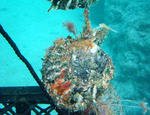
? IRD / M. Bouvy
Pearl oysters
Black pearl culture is currently the second greatest economic activity in French Polynesia after tourism. However, the young industry( 2) experienced a major crisis at the beginning of the 2000s. The pearl price per gram fell from 100 to below 5 US dollars in 25 years. Overproduction and disorganised trade circuits are responsible. Pearl culture is currently going through a recovery phase and trying to restore the balance between supply and demand. At once completely dependent on the "lagoon" ecosystem and with a strong impact on this ecosystem, pearl farms must face multiple constraints.
Sustaining the sector
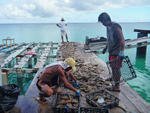
? IRD / B. Bourgeois
Grafting station
What are the best operating conditions to optimise production capacity and quality? Pearl size and quality are related to the attention given by producers to the culture cycle, but the farming environment remains decisive. In order to define the ideal conditions according to the lagoon environment, IRD researchers and their partners( 1) have been conducting an extensive research programme since 2008, regarding the Ahe atoll located 500 km north-east of Tahiti. The Ahe lagoon covers 145 km? and accounted for nearly 80 pearl concessions in May 2012.
The Ahe lagoon and pearl culture
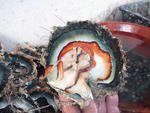
? IRD / B. Bourgeois
Pearl oyster
In order to assess the food resources available for pearl oysters in the South Pacific, called Pinctada margaritifera , researchers studied the spatial-temporal variations of the lagoon's planktonic communities over a year and their use by oysters. Result: molluscs retain more than 1% of the lagoon's primary production, i.e. organic plant matter. In fact, 80% of the latter is comprised of very small (less than 2 micrometres) organisms which are badly assimilated by oysters. Furthermore, the planktonic trophic network has been characterised, thanks to techniques used for the first time in an atoll environment and the project's numerous partners. Lastly, the study and modelling of water flow have enabled an understanding of how environmental conditions influence the dispersion of oyster larvae, and thus why particular areas of the lagoon are more favourable than others to the collection of spats, juvenile oysters.
Low chemical pollution
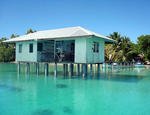
? IRD / M. Bouvy
Grafting station
The ecological impact of the pearl industry remains relatively unknown. Thousands of oysters have been artificially introduced into several lagoons. Sponges, anemones and other invasive epibionts, in other words living on other organisms such as oysters, were imported at the same time, increasing the health risk. Human populations around the farms can also pollute the lagoon. However, the work conducted by researchers on the Ahe atoll did not reveal any direct signs of chemical contamination of the environment or of eutrophication, i.e. the growth of algae due to an over-supply of nutrients( 3) which depletes the water of oxygen.
The work on the Ahe toll enables a better understanding of the lagoon environment in relation to the pearl farming business, which should enable, in the medium term, to improve the technical and economic performances of pearl farming in Polynesia.
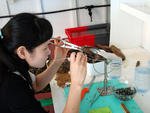
? IRD / M. Bouvy
Grafting
Did you know?
From the age of 2 to 3 years, pearl oysters are seeded with a small ball of nacre from a freshwater bivalve shell, the "nucleus", and a piece of mantle tissue taken from an oyster, the "graft". Over 18 months, a pearl will form and grow around the nucleus from the nacre of the graft.
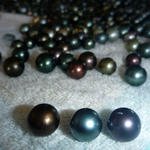
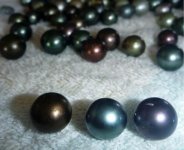
? IRD / M. Bouvy
Perles noires de Tahiti
The birth of pearl culture
Black pearl culture in French Polynesia has radically changed the landscapes and lifestyle of thousands of inhabitants of the Tuamotu Archipelago, employing up to 7,000 people( 4). Until the middle of the 20th century, wild P. margaritifera oysters were harvested only for their nacre. On some occasions, a natural pearl was discovered. The first transplant was carried out in 1961. The first commercial pearl operation was carried out in 1968. The two following decades saw gradual growth in economic activity, with the black pearl achieving the status of a high-quality gem on the international jewellery market. At the end of the1980s, the archipelago experienced a black pearl rush with thousands of Polynesians and foreigners coming to work in this remote region, before seeing its decline at the beginning of the 21st century.
1- This work was carried out in partnership with the Division of Marine Resources in French Polynesia, Ifremer, CNRS and the
universities of French Polynesia, Lille 1, Caen, La Rochelle and Aix-Marseille.
2-Compared to the over-a-century-old white and golden pearl industry in Asia and Australia, black pearl culture, developed only in the
1960s, is relatively new.
3-It contains mainly phosphorus and nitrogen from human activities.

The second greatest economic resource of French Polynesia after tourism, black pearl culture has been facing a major crisis since the first decade of this century. Overproduction, falling prices, reduced activity that had boosted many remote atolls... In response, IRD researchers and their partners( 1) are helping to maintain and sustain the sector.
In particular, scientists have been studying the Ahe atoll lagoon (north of Tahiti) since 2008. Specifically, they coordinated studies on the plankton resources available to feed oysters and on water flow in the lagoon.
These projects contribute to decision-making tools intended for oyster farmers, for the sustainable exploitation of the "Tahitian treasure".

? IRD / M. Bouvy
Pearl oysters
Black pearl culture is currently the second greatest economic activity in French Polynesia after tourism. However, the young industry( 2) experienced a major crisis at the beginning of the 2000s. The pearl price per gram fell from 100 to below 5 US dollars in 25 years. Overproduction and disorganised trade circuits are responsible. Pearl culture is currently going through a recovery phase and trying to restore the balance between supply and demand. At once completely dependent on the "lagoon" ecosystem and with a strong impact on this ecosystem, pearl farms must face multiple constraints.
Sustaining the sector

? IRD / B. Bourgeois
Grafting station
What are the best operating conditions to optimise production capacity and quality? Pearl size and quality are related to the attention given by producers to the culture cycle, but the farming environment remains decisive. In order to define the ideal conditions according to the lagoon environment, IRD researchers and their partners( 1) have been conducting an extensive research programme since 2008, regarding the Ahe atoll located 500 km north-east of Tahiti. The Ahe lagoon covers 145 km? and accounted for nearly 80 pearl concessions in May 2012.
The Ahe lagoon and pearl culture

? IRD / B. Bourgeois
Pearl oyster
In order to assess the food resources available for pearl oysters in the South Pacific, called Pinctada margaritifera , researchers studied the spatial-temporal variations of the lagoon's planktonic communities over a year and their use by oysters. Result: molluscs retain more than 1% of the lagoon's primary production, i.e. organic plant matter. In fact, 80% of the latter is comprised of very small (less than 2 micrometres) organisms which are badly assimilated by oysters. Furthermore, the planktonic trophic network has been characterised, thanks to techniques used for the first time in an atoll environment and the project's numerous partners. Lastly, the study and modelling of water flow have enabled an understanding of how environmental conditions influence the dispersion of oyster larvae, and thus why particular areas of the lagoon are more favourable than others to the collection of spats, juvenile oysters.
Low chemical pollution

? IRD / M. Bouvy
Grafting station
The ecological impact of the pearl industry remains relatively unknown. Thousands of oysters have been artificially introduced into several lagoons. Sponges, anemones and other invasive epibionts, in other words living on other organisms such as oysters, were imported at the same time, increasing the health risk. Human populations around the farms can also pollute the lagoon. However, the work conducted by researchers on the Ahe atoll did not reveal any direct signs of chemical contamination of the environment or of eutrophication, i.e. the growth of algae due to an over-supply of nutrients( 3) which depletes the water of oxygen.
The work on the Ahe toll enables a better understanding of the lagoon environment in relation to the pearl farming business, which should enable, in the medium term, to improve the technical and economic performances of pearl farming in Polynesia.

? IRD / M. Bouvy
Grafting
Did you know?
From the age of 2 to 3 years, pearl oysters are seeded with a small ball of nacre from a freshwater bivalve shell, the "nucleus", and a piece of mantle tissue taken from an oyster, the "graft". Over 18 months, a pearl will form and grow around the nucleus from the nacre of the graft.


? IRD / M. Bouvy
Perles noires de Tahiti
The birth of pearl culture
Black pearl culture in French Polynesia has radically changed the landscapes and lifestyle of thousands of inhabitants of the Tuamotu Archipelago, employing up to 7,000 people( 4). Until the middle of the 20th century, wild P. margaritifera oysters were harvested only for their nacre. On some occasions, a natural pearl was discovered. The first transplant was carried out in 1961. The first commercial pearl operation was carried out in 1968. The two following decades saw gradual growth in economic activity, with the black pearl achieving the status of a high-quality gem on the international jewellery market. At the end of the1980s, the archipelago experienced a black pearl rush with thousands of Polynesians and foreigners coming to work in this remote region, before seeing its decline at the beginning of the 21st century.
1- This work was carried out in partnership with the Division of Marine Resources in French Polynesia, Ifremer, CNRS and the
universities of French Polynesia, Lille 1, Caen, La Rochelle and Aix-Marseille.
2-Compared to the over-a-century-old white and golden pearl industry in Asia and Australia, black pearl culture, developed only in the
1960s, is relatively new.
3-It contains mainly phosphorus and nitrogen from human activities.
Last edited:
